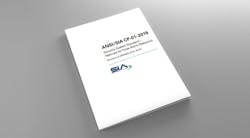SIA releases ANSI-approved false alarm reduction standard
The Security Industry Association (SIA) on Monday announced that it has released a new standard aimed at reducing false alarms. Approved by the American National Standards Institute (ANSI), the standard (known as ANSI/SIA CP-01-2019) leverages a mix of technology, industry experience and common knowledge to pinpoint the causes of and decrease the frequency of false alarm dispatches, detailing recommended design features applicable to both residential and commercial properties.
The 2019 standard is actually a revision of ANSI/SIA CP-01 2014 and builds on the 2014 version in several ways, including providing new guidance for handling informative signals and definitions for remote devices to reduce the frequency of false alarm dispatches and updated language throughout that minimizes the dependence on the term “control panel,” ensuring increased applicability to innovative security system approaches.
“When CP-01 was first released, we saw a significant reduction in false alarms, but as technology advances, so must the standards and processes that help reduce false alarms,” Joe Gittens, Director of Standards at SIA, said in a statement. “There is still a great deal of work to do industry-wide, but this release is a step forward, and we are excited to continue furthering the mission of eliminating false dispatches.”
The effort to update the standard was led by SIA’s Intrusion Subcommittee with input from The Monitoring Association (TMA) and the Electronic Security Association (ESA).
Addressing both user- and equipment-caused false alarms, CP-01-2019 is intended for use or reference by all security industry professionals. Areas covered by ANSI/SIA CP-01-2014 include event recognition, information handling sequences and provisions for system layout testing, installer programming options and recommended test procedures to help determine compliance to the standard.
For more information about the standard, click here.
